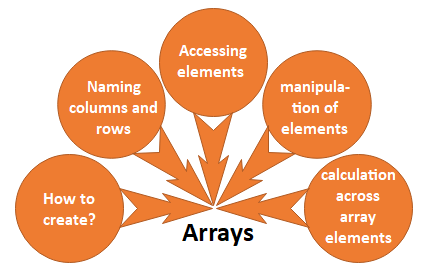📅 最后修改于: 2021-01-08 09:42:23 🧑 作者: Mango
R阵列
在R中,数组是数据对象,可让我们以二维方式存储数据。在R中,借助于array()函数创建一个数组。此array()函数将向量作为输入,并使用dim参数中的向量值创建一个数组。
例如-如果我们将创建一个尺寸为(2、3、4)的数组,则它将创建4个2行3列的矩形矩阵。
R数组语法
R数组具有以下语法:
array_name <- array(data, dim= (row_size, column_size, matrices, dim_names))
数据
数据是array()函数的第一个参数。它是输入向量,提供给数组。
矩阵
在R中,数组由多维矩阵组成。
row_size
此参数定义数组可以存储的行元素的数量。
column_size
此参数定义数组可以存储的列元素的数量。
dim_names
此参数用于更改行和列的默认名称。

如何创建?
在R中,数组创建非常简单。我们可以使用vector和array()函数轻松创建一个数组。在数组中,数据以矩阵形式存储。创建矩阵只有两个步骤,如下所示
- 第一步,我们将创建两个不同长度的向量。
- 一旦创建了向量,我们就将这些向量作为数组的输入。
让我们看一个示例,以了解如何在vectors和array()函数的帮助下实现数组。
例
#Creating two vectors of different lengths
vec1 <-c(1,3,5)
vec2 <-c(10,11,12,13,14,15)
#Taking these vectors as input to the array
res <- array(c(vec1,vec2),dim=c(3,3,2))
print(res)
输出量
, , 1
[,1] [,2] [,3]
[1,] 1 10 13
[2,] 3 11 14
[3,] 5 12 15
, , 2
[,1] [,2] [,3]
[1,] 1 10 13
[2,] 3 11 14
[3,] 5 12 15
命名行和列
在R中,我们可以为数组的行,列和矩阵指定名称。这是通过array()函数的dim name参数完成的。
不必为行和列指定名称。它仅用于区分行和列,以更好地理解。
下面是一个示例,其中我们创建两个数组,并为行,列和矩阵命名。
例
#Creating two vectors of different lengths
vec1 <-c(1,3,5)
vec2 <-c(10,11,12,13,14,15)
#Initializing names for rows, columns and matrices
col_names <- c("Col1","Col2","Col3")
row_names <- c("Row1","Row2","Row3")
matrix_names <- c("Matrix1","Matrix2")
#Taking the vectors as input to the array
res <- array(c(vec1,vec2),dim=c(3,3,2),dimnames=list(row_names,col_names,matrix_names))
print(res)
输出量
, , Matrix1
Col1 Col2 Col3
Row1 1 10 13
Row2 3 11 14
Row3 5 12 15
, , Matrix2
Col1 Col2 Col3
Row1 1 10 13
Row2 3 11 14
Row3 5 12 15
访问数组元素
像C或C++一样,我们可以访问数组的元素。借助索引访问元素。简单来说,我们可以在索引方法的帮助下访问数组的元素。让我们看一个示例,以了解如何使用索引方法访问数组的元素。
例
, , Matrix1
Col1 Col2 Col3
Row1 1 10 13
Row2 3 11 14
Row3 5 12 15
, , Matrix2
Col1 Col2 Col3
Row1 1 10 13
Row2 3 11 14
Row3 5 12 15
Col1 Col2 Col3
5 12 15
[1] 13
Col1 Col2 Col3
Row1 1 10 13
Row2 3 11 14
Row3 5 12 15
元素操纵
该数组由多维组成的矩阵,因此可以通过访问矩阵的元素来执行对数组元素的操作。
例
#Creating two vectors of different lengths
vec1 <-c(1,3,5)
vec2 <-c(10,11,12,13,14,15)
#Taking the vectors as input to the array1
res1 <- array(c(vec1,vec2),dim=c(3,3,2))
print(res1)
#Creating two vectors of different lengths
vec1 <-c(8,4,7)
vec2 <-c(16,73,48,46,36,73)
#Taking the vectors as input to the array2
res2 <- array(c(vec1,vec2),dim=c(3,3,2))
print(res2)
#Creating matrices from these arrays
mat1 <- res1[,,2]
mat2 <- res2[,,2]
res3 <- mat1+mat2
print(res3)
输出量
, , 1
[,1] [,2] [,3]
[1,] 1 10 13
[2,] 3 11 14
[3,] 5 12 15
, , 2
[,1] [,2] [,3]
[1,] 1 10 13
[2,] 3 11 14
[3,] 5 12 15
, , 1
[,1] [,2] [,3]
[1,] 8 16 46
[2,] 4 73 36
[3,] 7 48 73
, , 2
[,1] [,2] [,3]
[1,] 8 16 46
[2,] 4 73 36
[3,] 7 48 73
[,1] [,2] [,3]
[1,] 9 26 59
[2,] 7 84 50
[3,] 12 60 88
跨数组元素的计算
出于计算目的,r提供了apply()函数。此apply函数包含三个参数,即x,margin和函数。
此函数采用我们必须在其上执行计算的数组。 apply()函数的基本语法如下:
apply(x, margin, fun)
在此,x是一个数组,一个空白是所使用的数据集的名称,fun是要应用于该数组的元素的函数。
例
#Creating two vectors of different lengths
vec1 <-c(1,3,5)
vec2 <-c(10,11,12,13,14,15)
#Taking the vectors as input to the array1
res1 <- array(c(vec1,vec2),dim=c(3,3,2))
print(res1)
#using apply function
result <- apply(res1,c(1),sum)
print(result)
输出量
, , 1
[,1] [,2] [,3]
[1,] 1 10 13
[2,] 3 11 14
[3,] 5 12 15
, , 2
[,1] [,2] [,3]
[1,] 1 10 13
[2,] 3 11 14
[3,] 5 12 15
[1] 48 56 64